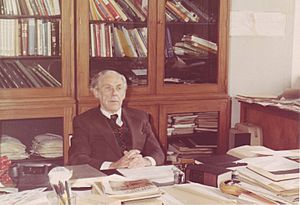Dan Eley facts for kids
Quick facts for kids
Professor
Dan Eley
|
|
|---|---|

Dan Eley at his desk at the University of Nottingham in 1980
|
|
| Born |
Daniel Douglas Eley
1 October 1914 |
| Died | 3 September 2015 (aged 100) Nottingham
|
| Citizenship | British |
| Alma mater | Manchester University |
| Awards | Officer of the Order of the British Empire (1961) Fellow of the Royal Society (1964) |
| Scientific career | |
| Institutions | University of Nottingham University of Bristol St John's College, Cambridge |
Daniel Douglas Eley (born October 1, 1914 – died September 3, 2015) was a very important British chemist. He was a Professor of Physical Chemistry at the University of Nottingham. He is well-known for helping us understand how chemicals react on surfaces. This discovery is called the Eley–Rideal mechanism.
About Dan Eley's Life
Dan Eley loved chemistry from a young age. He earned his first degree in Chemistry from the University of Manchester in 1934. He continued his studies there and got a master's degree in 1935.
He then worked on his PhD with a famous scientist named Michael Polanyi. After finishing that in 1937, he moved to St John's College, Cambridge. There, he earned a second PhD in 1940, working with Eric Rideal.
In 1945, Dan Eley started teaching at the University of Bristol. He became a professor there in 1951. Later, in 1954, he became the very first Professor of Physical Chemistry at the University of Nottingham.
His amazing work was recognized with several awards. In 1961, he was made an Officer of the Order of the British Empire (OBE). This is a special honor from the British Queen or King. In 1964, he was chosen to be a Fellow of the Royal Society. This is a big deal for scientists in the UK.
His Work in Science
Professor Eley played a huge role in building up the School of Chemistry at the University of Nottingham. He worked with other professors to create a new Chemistry building in 1960. This helped many students and researchers.
He studied many different areas in chemistry. Some of these included:
- Catalysis: How substances speed up chemical reactions.
- Organic Semiconductors: Materials that can conduct electricity, like those in computer chips.
- DNA Conductivity: He even showed that DNA, our genetic material, can conduct electricity. This was important for understanding how DNA can be damaged.
- Molecular Sieves: Materials with tiny holes that can separate molecules.
Professor Eley also worked closely with companies. Money from a company called ICI helped set up a special center for studying colloids. Colloids are mixtures where tiny particles are spread throughout another substance, like milk or fog.
He led a large team of researchers and published over 250 scientific papers. Many of these papers are still used and referenced by scientists today. He retired in 1980 but continued to work with his colleagues and publish new findings.
One of his most famous discoveries was the Eley–Rideal mechanism. He worked with Sir Eric Rideal to study how catalysts help reactions. They focused on how hydrogen reacts with carbon compounds. Their experiments led to understanding this important chemical process.
During his time, he also tutored Rosalind Franklin. She later became famous for her work on the structure of DNA.
In 2004, when he turned 90, a famous science magazine called Nature gave him a lifetime subscription. He celebrated his 100th birthday in 2014! To mark this special occasion, the University of Nottingham held an event. He also received a certificate for being a Fellow of the Royal Society for 50 years. The Royal Society of Chemistry also honored him with a special blue plaque.

